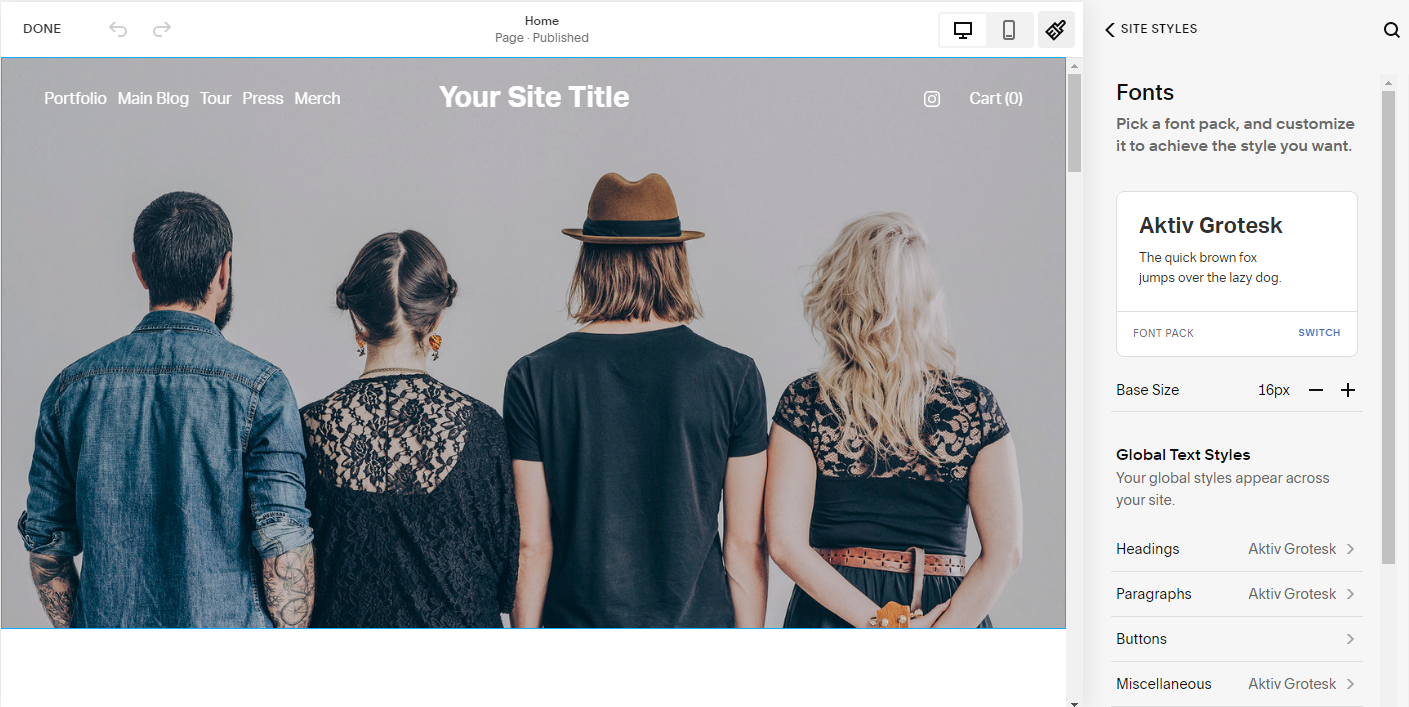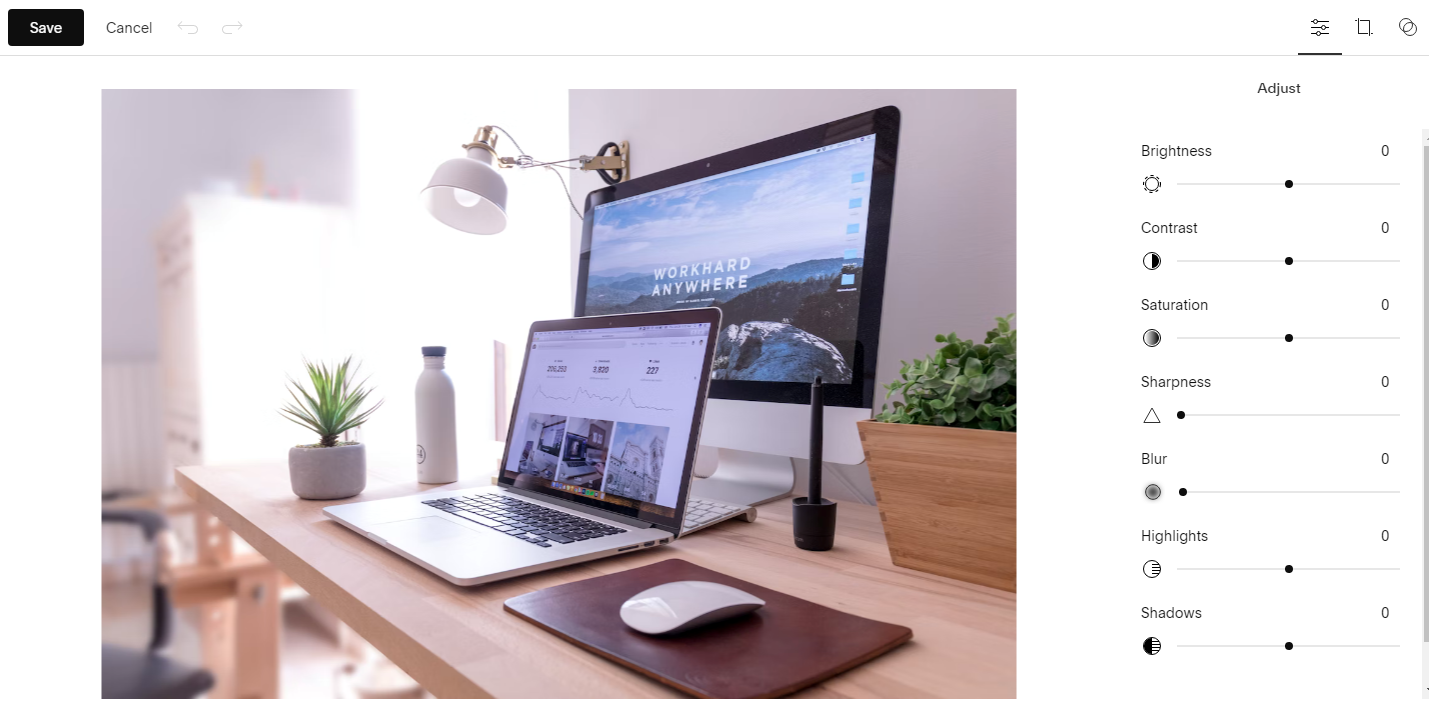8 Easy Steps to Brand your Squarespace E-Commerce Website
Image credits belong to Domenico Loia
McDonald’s, Nike, Pixar - all household names, all from different industries but with one very important common emphasis: branding. We might think that it’s the most financially-sound decisions or the best operation strategies that drive a business to success, but in reality, there’s little match for the power and effect that branding holds.
Not only does effective branding help establish a business image, but it also helps you connect with your target market, helping your business in sales. And of course, it’s branding that differentiates one competitor from another and drives the concept of consumer loyalty.
Very rarely is it the product alone that wins over a customer, but the entire experience of being a customer of that brand that determines consumer preferences and loyalty.
And for Squarespace e-commerce website, branding is just as important as for any other business. Not only is it going to determine whether a customer will go down the ‘returning’ or ‘not again’ lane, but your branding will also play a part on how much traffic your website will get.
But how are you supposed to brand an e-commerce website? Well, it’s a process!
And here are some of the best branding tips for your Squarespace e-commerce website:
Step #1. Know Your Customer
Before you even get to branding your e-commerce website, it’s important to know who your customer is.
Start by conducting market research to first determine your target market and then discover their preferences and buying habits. You can also create user personas to help you in this process and better align your e-commerce business with your expected customer.
Once you’ve got a good grip on who you’re catering to, then you can go ahead and brand your website accordingly!
Step #2. Choose a Color Scheme
The first course of action for any e-commerce website, not just Squarespace, is to choose a color scheme.
Squarespace website’s color presets
Now, don’t go blindly choosing a color that you like - while it’s completely okay to add in preferences and keep favorite colors in mind, there’s a whole psychology behind selecting a color. Certain colors signify certain moods and characteristics, and your customers will inevitably grow to align your brand with them.
While colors aren’t clear cut they’re always influenced by personal experiences and preferences. Color schemes hold some weight in how your e-commerce website will be perceived.
In fact, some of the most famous brands out there have used color purposely. For instance, the color red has been shown to increase the viewer’s appetite - which is why brands such as Chick-fil-A, Kellog’s, and The Coca-Cola Company have all based their identity around the red color.
So choose your color scheme according to what industry your e-commerce website is operating in. Here’s some good example, use purple if you’re dealing in luxury products or green if your brand is environment-first.
Once you’ve decided on the main block color, you can variate between shades in the range to find your perfect complement.
Fortunately, Squarespace’ built in themes conveniently comes with pre-combined colors and offers variation of its shades.
HOW TO CHANGE YOUR SQUARESPACE WEBSITE’S COLOR SCHEME
You can easily change your Squarespace website’s color scheme in a few clicks.
Simply go to Design on your Squarespace website’s top menu
Click Site Styles and click Colors.
From here, you can click on any of the shade variation under Customize your Themes or you can click the Edit Palette
And change your main color.
Step #3. Design a Logo
So, you’ve locked a color palette, congratulations! The next step is to design a logo. Sounds daunting, right?
Well, it doesn’t have to be. Some of the best logos out there are actually pretty simple - take a look at Mcdonald’s and Nike again, pretty simple, right? But effective like anything!
Read up on the types of logos - there are actually 7 - and see which most aligns with how you picture your brand to be. Whether you go down the wordmark route or the pictorial mark path, make sure that your logo’s imagery helps the viewer connect with your business.
Remember, logos are a great place to bring in deeper meanings!
Step #4. Typography
Ever came across a website with text that’s so hard to read it made your head hurt? Maybe the font was all wrong or maybe the text color was just not working, either way, you probably didn’t explore that website any further - and you certainly didn’t make any purchases!
Different fonts style convey different character. (Image by Jon Tyson.)
A crucial part of e-commerce branding is your website’s typography. Not only does your font style affect audience behavior and perception, but it also impacts the image that customers have of your brand. While there are dozens of fonts to choose from, there are five main font types that you can browse, helping you select ones that match your desired brand image.
For instance, you can incorporate script fonts or handwritten fonts on your ‘About Me’ or ‘Meet the Team’ page as well as for your customer reviews - all in a bid to add authenticity to the communication and make people across the screen seem like real people.
Fortunately, changing font styles in Squarespace is super easy.
HOW TO CHANGE YOUR SQUARESPACE WEBSITE’S FONT STYLES in 4 STEPS
It’s easy to change font styles in Squarespace, no need to code. Just click and select.
Simply go to Design on your Squarespace website’s top menu
Click Site Styles and click Fonts.
From here, set any of the specific or generic font style settings for your website.
Choose a font preset with Font Pack
Change font size with Base Size
Change font style for all your pages with Global Text Styles
Set font style only for specific sections of your site in Assign Styles
Click DONE or SAVE to save your changes.
And of course, whatever font style you end up choosing, make sure to adjust font sizes and colors accordingly. There’s nothing worse than text that’s hard to read!
Step #5. Voice and Values
Contrary to popular belief, branding is not all about visuals. A very important aspect of branding your e-commerce website is to decide on and actualize your brand’s voice and values.
What is a brand’s voice?
Voice, is how your brand comes across to its customers. Just like a person and the role that they’re adopting, a company also has a certain distinguishable voice and depending on their industry and target market, the voice can vary.
Your e-commerce website’s voice can range from playful and funny to supportive and helpful to sophisticated - and many more!
Before deciding on the voice persona that you want to pursue, take a good look at your business, its customers, and the industry that it’s operating in.
Whatever voice you choose, make sure to incorporate it in all communication - and of course, you can switch it up depending on the matter, but the overall personality should remain the same! Not only will this bring solidity, but it’ll also make you more recognizable in the market, helping your e-commerce website truly create a brand of its own.
Find your business’ values
Values are what your e-commerce website as a business holds in importance, and what you further want to impart to your customers. For instance, the luxury fashion house Christian Dior lists innovation and excellence as their values, whereas the retail chain Target names inclusivity, connection, and drive as theirs.
To find what your values are, it’s important to introspect and look at what is important to you and your product - are you providing safety? Comfort? Luxury?
And for inspiration, you can look towards some of your favorite brands - if there’s a brand image you particularly like, their values might be worth exploring.
Step #6. Honest Photography
Part of running an e-commerce business is realizing that your customers won’t be able to physically see and hold your products, so they’ll be relying on whatever information that you provide them with.
A branding step that you can take to make your customer’s experience smoother is to practice honest photography. Honest photography means that you’ll accurately depict what your products look like via images on your website.
And with Squarespace, you have a lot options to showcase your photos. From photograph oriented themes, to Portfolio pages, to Gallery section and blocks - there’s even a built-in image editor so you won’t have to import/export your images to enhance them.
Squarespace offers a lot of flexibility to highlight your creativity.
Of course, you should strive to take flattering pictures and stylize your photos so that they are in line with your website’s overall brand. Not only will this make your website look more attractive and increase your sales turnover, but it will also make your business reputable in the market due to its authenticity.
Accompany your images with product descriptions and relevant details to really seal the deal and secure your customers!
Step #7. Share Your Story
As people, we often have life-altering stories that lead to where we are in the current time period - and the same holds true for the businesses that we run. One of the main motives behind branding is to connect with the customer, and a great way to do that is by sharing your e-commerce website’s story.
You might be confused about what it means to share your website’s story. Well, it means sharing the process of its creation, the purpose and values behind its existence, and the individuals behind it all.
Don’t know where to start? No worries, Squarespace already has you covered.
Select ‘About’ and pick a layout.
HOW TO SHARE YOUR STORY WITH SQUARESPACE ABOUT PAGE
Click the ‘+’ icon to add a new page
Click ‘Page Layouts’
Click ‘About’ in the page selections in the left
Choose the layout you like
Upload your images and add your story in the text boxes
By sharing your story - and more - you humanize your e-commerce business, making it seem more approachable which will bring you more customers!
Step #8. Use a Brand Kit
No matter how efficient you are, branding your e-commerce website can sometimes get the best of you. Well, to make things easier for yourself you can take some help from PosterMyWall’s brand new Brand Kits!
Visit PosterMyWall to create your brand logos.
This unique feature allows users to create and save logos, your brand’s color schemes, and select branded fonts and imagery all within the PosterMyWall editor. And since it’s so easy to use, you won’t need to hire a professional - saving you bucks and letting you unleash your creative side!
Whether you want to start from scratch, use existing templates, or incorporate a mix of the two, once you create a Brand Kit with PosterMyWall, all of your SquareSpace website’s branding needs will be satisfied!
So…
Consider these tips and tricks if you’re looking to brand your SquareSpace e-commerce website. And be sure to switch things around and see what works best for your brand ‘cause remember, branding is all about trial and error, so keep at it!
This content was submitted by Lyba Nasir. If you’re interested in working with Lyba, click here.
Most Squarespace E-Commerce websites use our Universal Filter Plugin.








